Chlorophenols in marine organisms from the southern coast of Hangzhou Bay, China, and an assessment of risks posed to human health*
ZHENG Dan (郑丹) JIAO Haifeng (焦海峰) ZHONG Huiying (钟惠英)QIU Jishi (邱纪时) YAN Xiaojun (严小军) DUAN Qingyuan (段清源)CHAI Liyue (柴丽月)
1School of Marine Science,Ningbo University,Ningbo 315211,China
2Ningbo Academy of Oceanology and Fishery,Ningbo 315010,China
AbstractThe composition of chlorophenols in marine organisms from the southern coast of Hangzhou Bay, China, was analyzed and the health risks posed to humans assessed. A total of 19 chlorophenols from 16 types of marine organism were analyzed across nine survey sections in Hangzhou Bay. The chlorophenols were analyzed by gas chromatography-mass spectrometry using a DB-5MS quartz capillary column. The concentrations of monochlorophenol, dichlorophenol, trichlorophenol, tetrachlorophenol, and pentachlorophenol ranged from below the detection limit (ND) to 132 μg/kg, ND-51.0 μg/kg, ND-42.5 μg/kg, ND-69.0 μg/kg, and ND-9.06 μg/kg, respectively. Additionally, concentration differences between each type of chlorophenol were not significant (P>0.05). However, significant differences were found between monochlorophenol (F=8.13,P<0.01) and total chlorophenol (F=5.19,P<0.01) concentrations. As the noncarcinogenic risk indices were <0.1 (10- 5-10- 2) for all of the organisms, no high risk was posed by 2-chlorophenol, 2,4-dichlorophenol, 2,4,6-trichlorophenol, 2,4,5-trichlorophenol, 2,3,4,6-tetrachlorophenol,and pentachlorophenol to humans consuming marine organisms from the study area. Furthermore, the carcinogenic risks posed by 2,4,6-trichlorophenol and pentachlorophenol were lower than limits set by the International Commission on Radiological Protection and the US Environmental Protection Agency.However, the noncarcinogenic and carcinogenic risks posed by chlorophenols in marine organisms from four of the survey sections (Sizaopu, Niluoshan, Longshan Town and Xinhong zha) were higher than the other survey sections.
Keyword:Hangzhou Bay; chlorophenols; marine organisms; health risk
1 INTRODUCTION
Chlorophenols are important environmental pollutants because they are toxic, persistent and have been used widely (Häggblom and Bossert, 2003;Dorsey and Tchounwou, 2004; Chen et al., 2010).They are classified as priority pollutants by the US Environmental Protection Agency (EPA) (Capito et al., 1997). There are 19 different chlorophenol compounds, which can be divided into five groups according to the number of chlorine substituents. The five groups are monochlorophenols (CPs),dichlorophenols (DCPs), trichlorophenols (TCPs),tetrachlorophenols (TTCPs) and pentachlorophenol(PCP). Chlorophenol residues have been found in water, air, soil and food products, as well as the tissues and bodily fluids of organisms around the world(Crosby, 2009; Olaniran and Igbinosa, 2011). An environment can become contaminated with chlorophenols when they are present in industrial eラ uent and agricultural runoff, produced through the breakdown of chlorophenoxyacetic acid herbicides and hexachlorobenzene present in the environment,and spontaneously formed when water is chlorinated to disinfect and deodorize it (Murcia et al., 2007;Yang and Lee, 2008). Many chlorophenol compounds and their metabolites pose health hazards because they are toxic to many organisms (Giulio et al., 1989;Peng et al., 2016). The primary source of chlorophenols to humans is food (Jiang et al., 2005). The consumption of marine products in China has increased dramatically in recent decades because of rapid economic development and improvements in living standards(Meng et al., 2007). Thus, the health risks posed by chlorophenols to humans consuming marine organisms contaminated with chlorophenols are expected to increase because of the huge amounts of persistent organic pollutants, including chlorophenols,released into coastal waters (Kond et al., 2005; Ma et al., 2012; Vlastos et al., 2016).

Fig.1 The location of the study area and offshore survey sections along the south coast of Hangzhou BayHJB: Huangjiabu; LS: Linshan; HZB: Hangzhou Bay; XCE:Xiaocao’e River; SZP: Sizaopu; QBI: Qizibamei Islands; LST:Longshan Town; NLS: Niluoshan; XHZ: Xinhong zha.
Hangzhou Bay, the only estuary-type gulfin China,is in the northern part of Zhejiang Province, south of Shanghai and east of the Zhoushan Islands. The economy around Hangzhou Bay has developed rapidly over the past 30 years. Hangzhou Bay is world famous for its seafood, and edible marine organisms are an important food source for the residents in the area. Many chemical plants have been built on both sides of Hangzhou Bay since the 1990s and preliminary statistics indicate that more than 200 chemical companies have plants in the region. There are also several waste dismantling sites in the Hangzhou Bay area. However, little information is available on chlorophenols in biotic and abiotic matrices in coastal areas of Hangzhou Bay. The only published survey of chlorophenol concentrations in Hangzhou Bay was reported by Qiu et al. (2016), who found 16.7 to 2.18×104ng/L total chlorophenols in seawater along the south coast of Hangzhou Bay.Additionally, PCP concentrations of 0.57-4.30 μg/kg have been found in sediment in the Zhujiang River estuary (Dong et al., 2009).
Therefore, very little is known about the concentrations of the 19 chlorophenols present in biota in Hangzhou Bay, and few studies have investigated human health risks posed by chlorophenols in edible marine organisms. In this study, samples of 16 edible marine organisms were collected from the south coast of Hangzhou Bay.The chlorophenol concentrations in the samples were determined and the potential health risks posed to humans consuming the organisms were assessed.
2 MATERIAL AND METHOD
2.1 Sample collection
Marine organisms were collected from nine survey sections along the south coast of Hangzhou Bay,Zhejiang Province, China, between January and June 2014 (Fig.1). The collected species were selected based on catch statistics and a survey of the diets of local people. In total, samples from 16 species were collected: tongue sole (Cynoglossussemilaevis),shuttles hoppfish (Periophthalmusmodestus), eel goby (Odontamblyopusrubicundus), javelin goby(Synechogobiushasta), tapertail anchovy (Coilia mystus), croaker (Collichthyslucidus), Japanese seabass (Lateolabraxjaponicus), flathead grey mullet(Mugilcephalus), sea melon seed (Moerella iridescens), saltwater clams (Potamocorbulalaevis),Korean mud snail (Bullactaexarata), Chinese razor clam (Sinonovaculaconstricta), mud crab (Scylla paramamosain), fi ddler crab (Ucaarcuata), mudf l at crab (Helicetridens), and ridgetail prawn(Exopalaemoncarinicauda). The samples were collected randomly from local fi shing boats as soon as the boats entered port. The samples were kept in iceboxes and transported to the laboratory as quickly as possible, where they were then stored at -20°C until analysis.
2.2 Sample analysis
The samples were analyzed for chlorophenols following procedures described by Zhong et al. (2016)and de Morais et al. (2012). A 100-μL aliquot of deuterated 2,4,6-tribromophenol (internal standard)was added to each sample, then the sample was digested in 50% H2SO4in a water bath at 40°C for 6 h. The digest was then extracted with 10 mL of a 4:1 mixture of cyclohexane and ethyl acetate. The mixture was centrifuged, and the supernatant shaken for 1 min with 4% NaOH. The organic phase was removed,5 mL ofn-hexane was added, and the mixture was then shaken for 2 min. The organic phase was then removed and 10 mL of a 1:1 mixture ofn-hexane and dichloromethane was added and the mixture shaken for 1 min. The organic phases were combined and passed through a column containing anhydrous Na2SO4, then evaporated to 400 μL using a Termovap Sample Concentrator (N-EVAP system, China), after which 10 μL of deuterated 4-chloro-3-methylphenol and 40 μL of N,O-bis(trimethylsilyl)trif l uoroacetamide were added. The mixture was kept at 40°C for 30 min for derivatization, and then the mixture was evaporated to dryness and diluted to 50 μL withn-hexane.
The chlorophenol concentrations in each extract were determined by gas chromatography-mass spectrometry using a Thermo Finnigan Trace GCDSQ instrument (Thermo Fisher scientific, Waltham,MA, USA). Separation was achieved with a DB-5MS quartz capillary column (60 m long, 0.25 mm i.d.,0.25 μm fi lm thickness; Agilent Technologies Inc.,Santa Clara, CA, USA). A sample aliquot (2 μL) was injected into the PTV injection port in solvent-vent mode at an initial temperature of 20°C, vent flow of 50 mL/min, and venting time of 0.75 min. After venting, the split valve was closed and the PTV injection port liner was flash-heated to 260°C (which was maintained until the end of the analytical run) to transfer the analytes from the injection port liner to the capillary column. The oven temperature program started at 80°C, which was maintained for 1 min,increased at 10°C/min to 160°C, then increased at 3°C/min to 200°C, and fi nally increased at 40°C/min to 300°C, which was held for 3 min. This temperature program separated all 19 chlorophenols adequately during a chromatographic run lasting 26 min with a carrier gas flow rate of 1.0 mL/min. The quadrupole mass spectrometer ion source temperature was 230°C,the quadrupole temperature was 150°C, and the transfer line temperature was 250°C. The solvent delay time was 10.5 min. The mass spectrometer was operated in electron impact ionization mode using an ionization voltage of 70 eV. Selected ion monitoring mode was used to acquire data to calibrate the instrument and quantify the analytes.
A total of 19 chlorophenols were identified and quantified: the CPs 2-CP, 3-CP and 4-CP; the DCPs 2,3-DCP, 2,4-DCP, 2,5-DCP, 2,6-DCP, 3,4-DCP and 3,5-DCP; the TCPs 2,3,4-TCP, 2,3,5-TCP, 2,3,6-TCP,2,4,5-TCP, 2,4,6-TCP and 3,4,5-TCP; the TTCPs 2,3,4,5-TTCP, 2,3,4,6-TTCP, 2,3,5,6-TTCP and PCP.Internal reference standards were used to identify and quantify the individual compounds. The chlorophenol standards were purchased from Organic Standards Solutions International (Charleston, SC, USA). The internal standards, deuterated 4-chloro-3-methylphenol and deuterated 2,4,6-tribromophenol(purity 98%), were manufactured by C/D/N Isotopes(Pointe-Claire, Canada).
2.3 Quality assurance and quality control
The linear correlation coeffcients of the calibration curves for all 19 chlorophenols were >0.999. Seven standards were used to establish the calibration curves and the chlorophenol concentrations in the standards were 2.00, 6.00, 10.0, 20.0, 30.0, 40.0, and 70.0 ng/mL. PCP at a concentration of 0.4 μg/kg gave a signal-to-noise ratio of 5, and 3-CP at a concentration of 0.2 μg/kg gave a signal-to-noise ratio of 18. The detection limits for the chlorophenols were therefore between 0.2 and 0.4 μg/kg. The recovery rates and standard deviations were determined by analyzing 18 samples each of ridgetail prawn, Japanese seabass,and Chinese razor clam. Three samples of each species were spiked with internal standards at a concentration of 1.00, 3.00, and 7.00 μg/kg so that each species at each spike concentration was analyzed six times.
The recoveries were 61.6%-88.2% for 2-CP,58.0%-76.3% for 3-CP, 55.2%-75.0% for 4-CP,75.3%-114% for 3,5-DCP, 76.7%-116% for 2,5-DCP, 66.0%-92.3% for 2,6-DCP, 63.0%-110% for 2,4-DCP, 65.5%-98.8% for 2,3-DCP, 68.0%-93.1%for 3,4-DCP, 80.0%-116% for 2,4,6-TCP, 81.3%-104% for 2,3,5-TCP, 78.0%-110% for 2,4,5-TCP,78.0%-102% for 2,3,6-TCP, 80.7%-108% for 3,4,5-TCP, 76.0%-104% for 2,3,4-TCP, 86.2%-116% for 2,3,5,6-TTCP, 85.0%-118% for 2,3,4,6-TTCP,78.0%-125% for 2,3,4,5-TTCP and 83.2%-104% for PCP. The relative standard deviation for all 19 chlorophenols was <10.9%.

Table 1 Average daily consumption of marine organisms determined by interviewing residents in the study area
2.4 Risk assessment
The criteria proposed by the US EPA are traditionally used to assess potential risks posed by contaminants, including noncarcinogenic and carcinogenic effects (U.S. Environmental Protection Agency, 1992; Strenge and Chamberlain, 1995; Liu et al., 2013).
The long-term daily intake dose (CDI) is calculated for exposure through intake using:

whereρis the contaminant concentration (mg/kg) in a marine organism,Uis the amount of the marine organism consumed each day (g/d), Efis the exposure frequency (d/yr; the Efin our survey area was 156 d/yr), ED is the exposure delay (ED=70 yr(noncarcinogenic substances), ED=30 yr (carcinogenic substances)), BW is body weight (kg; 60 kg for an adult), and AT is the average exposure time (AT=30 yr(noncarcinogenic substances), AT=70 yr (carcinogenic substances)). The daily consumption valueUwas determined by interviewing 65 local residents (32 men and 33 women) with an average age of 44±16 yr (range 18-74 yr). The marine organism intake was determined by dividing daily consumption by body weight (60 kg).Our survey indicated that a typical adult in the study area consumes 156.88±125.25 g of seafood each day(Table 1).
The noncarcinogenic risk index was calculated from the daily intake and the reference dose using the equation:

where RfD is the reference dose (mg/(kg·d)). The reference dose suggested by the US EPA was used.
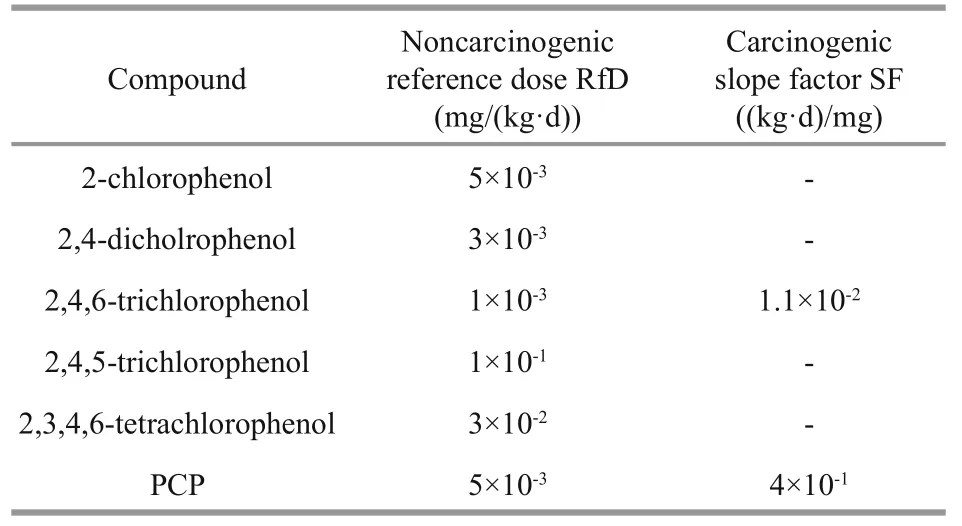
Table 2 Toxicological parameters for different chlorophenols
The acceptable carcinogenic risk dose suggested by the US EPA was used. Low and high carcinogenic risks are usually calculated:
Low concentration exposure=CDI×SF.
If the result is >0.01 the high concentration equation should be used:
High concentration exposure=1-e(-CDI×SF).
In these equations, Sfis the carcinogenic slope factor ((kg·d)/mg) for a particular contaminant.
3 RESULT
3.1 Chlorophenol concentrations in marine organisms
A total of 108 edible marine organisms, commonly found in Hangzhou Bay and consumed by humans,were analyzed, encompassing eight fi sh species, four shellfish species and four crustacean species.Chlorophenols were detected in all of the samples(Table 3), and even though the detection rates for different chlorophenols were different, the results indicated that chlorophenols are widespread in marine organisms. The average CP, DCP, TCP, TTCP, and PCP concentrations were below the detection limit(ND) to 132 μg/kg, ND-51.0 μg/kg, ND-42.5 μg/kg,ND-69.0 μg/kg, and ND-9.06 μg/kg, respectively.The lowest total chlorophenol concentrations were found in croaker, Korean mud snail, ridgetail prawn,Chinese razor clam, and mud crab. The highest CP and PCP concentrations were found in sea melon seed. The highest TCP and TTCP concentrations were present in Chinese razor clam. The highest DCP concentrations were found in shuttles hoppfish.Although the chlorophenol concentrations in different organisms were different, there were no significant differences between the chlorophenol concentrations at each chlorination level in the different organisms(P>0.05).
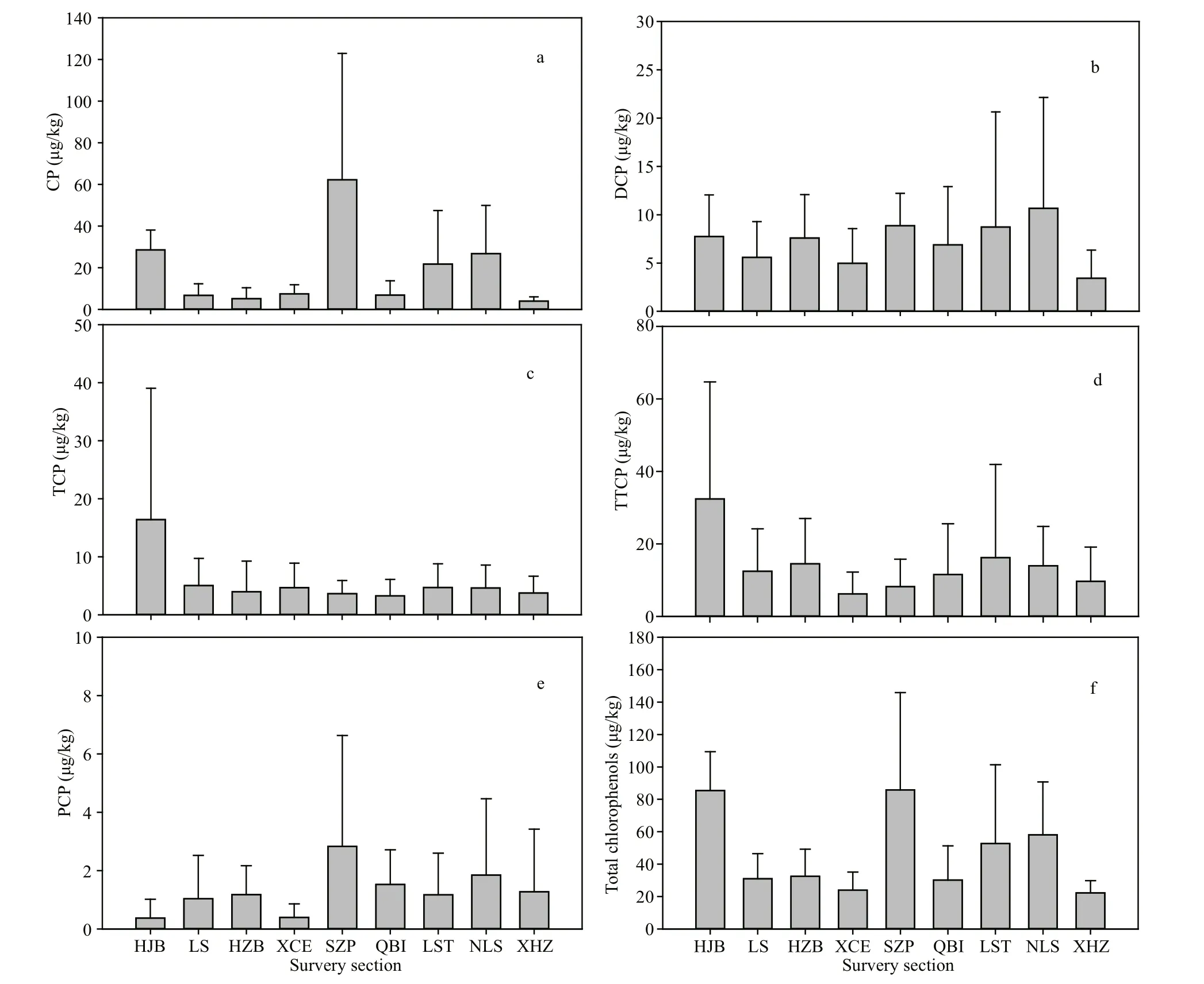
Fig.2 Chlorophenol concentrations in samples from the nine survey sections: (a) monochlorophenol, (b) dichlorophenol, (c)trichlorophenol, (d) tetrachlorophenol, (e) pentachlorophenol, (f) total chlorophenols
3.2 Distribution of chlorophenol residues
The chlorophenol concentrations were very different in samples from the various survey sections(Fig.2). The data were subjected to analyses of variance, which showed significant differences between the CP concentrations (F=8.13,P<0.01) and the total chlorophenol concentrations (F=5.19,P<0.01) in the samples from the different survey sections. Differences were also found between the TCP concentrations in samples from different survey sections, but the differences were not statistically significant. No differences were found between dichlorophenol or tetrachlorophenol concentrations(P<0.01). We concluded that the chlorophenol concentrations were higher in samples from some survey sections, particularly SZP, HJB, and NLS.
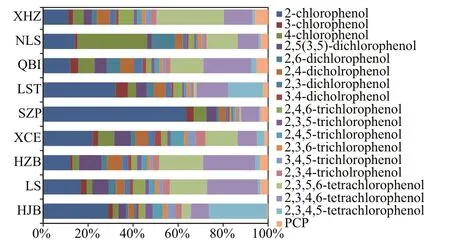
Fig.3 Chlorophenol congener profi les in the samples from the nine survey sections
3.3 Chlorophenol congener profi les
In general, the chlorophenol congener profi les were different for samples from the different survey sections (Fig.3). 2-CP was the dominant chlorophenol,contributing >10% of the total chlorophenol concentrations, especially at SZP for which 2-CP contributed >60% of the total chlorophenol concentration. We suggest that 2-CP could be used to indicate new potential sources of chlorophenol input.After 2-CP, 2,3,4,6-TTCP and 2,3,5,6-TTCP contributed more than other chlorophenols to the total chlorophenol concentration. 4-CP contributed >20%of the total chlorophenol concentration in samples from the NLS section and 2,3,4,5-TTCP contributed>20% of the total chlorophenol concentration in samples from the HJB section. PCP was detected in samples from all sections and contributed more (>7%)to the total chlorophenol concentration in samples from the NLS section than from the other sections.
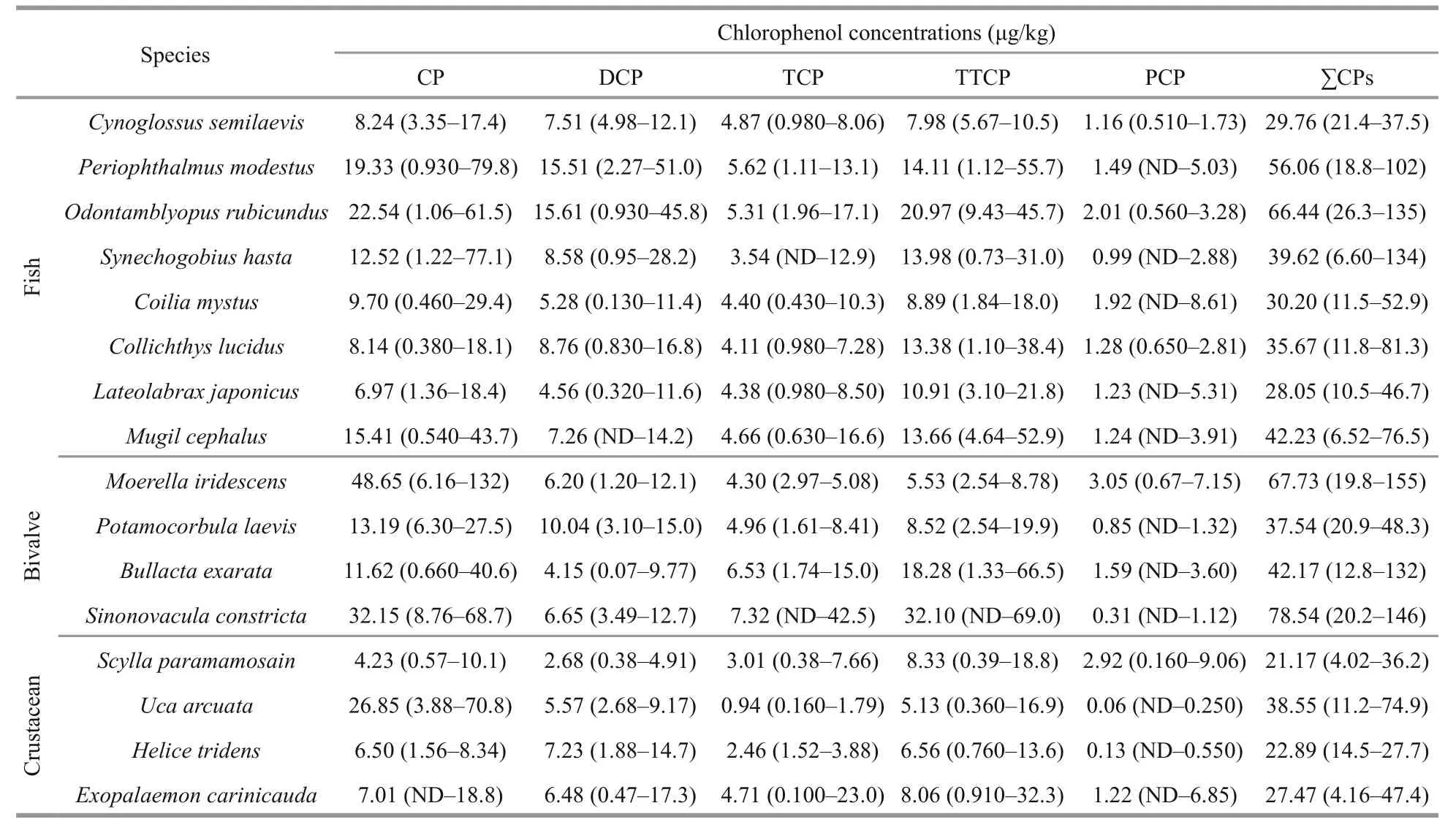
Table 3 Chlorophenol concentrations in marine organisms from Hangzhou Bay
4 DISCUSSION
4.1 Chlorophenol concentrations
The total chlorophenol, PCP, and 2-CP concentrations in samples from the south coast of Hangzhou Bay were 4.02-146 μg/kg, ND-9.06 μg/kg, and ND-126 μg/kg, respectively. It was recently reported that phenolic organohalogen compounds,such as chlorophenols, produced by the chemical industry are widely distributed in the environment and organisms (Czaplicka, 2004; Luo et al., 2009; Jin et al., 2012a). Previous research on chlorophenols in the environment has mainly focused on PCP and 2,4,6-TCP (Yin et al., 2003; Besser et al., 2005;Cooper and Jones, 2008) and little information on all 19 chlorophenols is available (Zheng et al., 2012).Chlorophenol concentrations in various parts of the world, including Canadian estuaries (Metcalfe and Hayton, 1989; Rogers et al., 1989), the USA (Murray et al., 1981), and other parts of China (Liu, 2013;Feng, 2014), are shown in Table 4. Because it appears that chlorophenols have been released from a range of chemical plants, we assessed both the noncarcinogenic and carcinogenic risks posed by chlorophenols to humans.
The 2-CP concentrations were higher than the PCP concentrations in our samples, possibly because of the Specific types of chemical waste discharged into Hangzhou Bay. The highest 2-CP concentrations were found in sea melon seed (126 μg/kg), Chinese razor clam (63.5 μg/kg) and eel goby (53.2 μg/kg). The PCP concentrations in our samples were higher than in samples from Dongting Lake (China), but lower than samples from the Upper Fraser River (Canada).The PCP concentrations in our samples were similar to concentrations in samples from the San Luis River(Canada) and the total chlorophenol concentrations in our samples were similar to concentrations from theRainy River (Canada) and Dongting Lake (China).Concern should thus focus on the presence of chlorophenols in environmental media because chlorophenols are widely distributed around the world.

Table 4 Chlorophenol concentrations in marine organisms from different regions
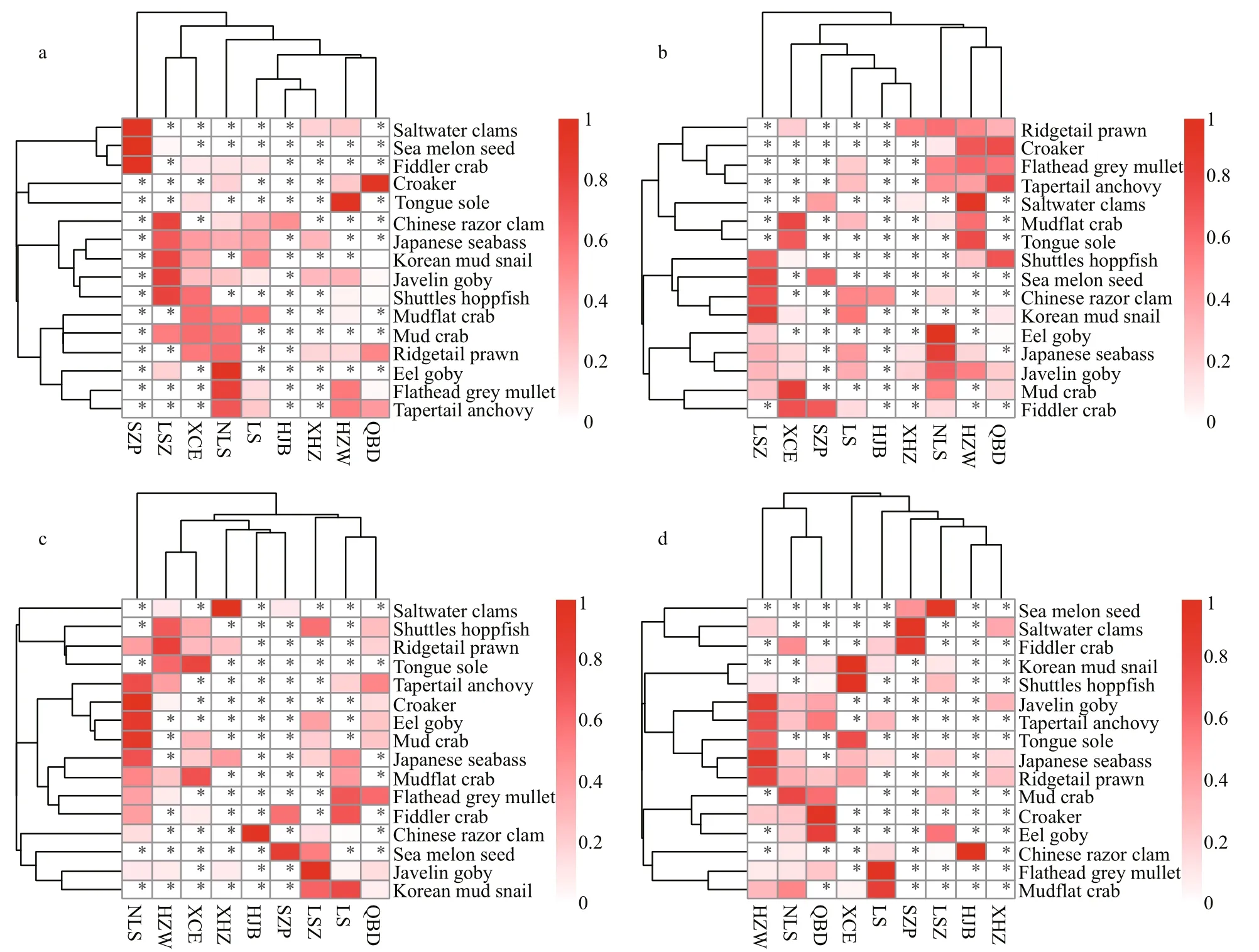
Fig.4 Heatmaps for noncarcinogenic and carcinogenic risks of chlorophenols in the different organisms and survey sectionsa-g. noncarcinogenic risks: a. 2-chlorophenol; b. 2,4-dichlorophenol; c. 2,4,6-trichlorophenol; d. 2,4,5-trichlorophenol; e. 2,3,4,6-tetrachlorophenol; f.pentachlorophenol; g. total chlorophenols; h-j. carcinogenic risks: h. 2,4,6-trichlorophenol; i. pentachlorophenol; j. total chlorophenols.To be continued
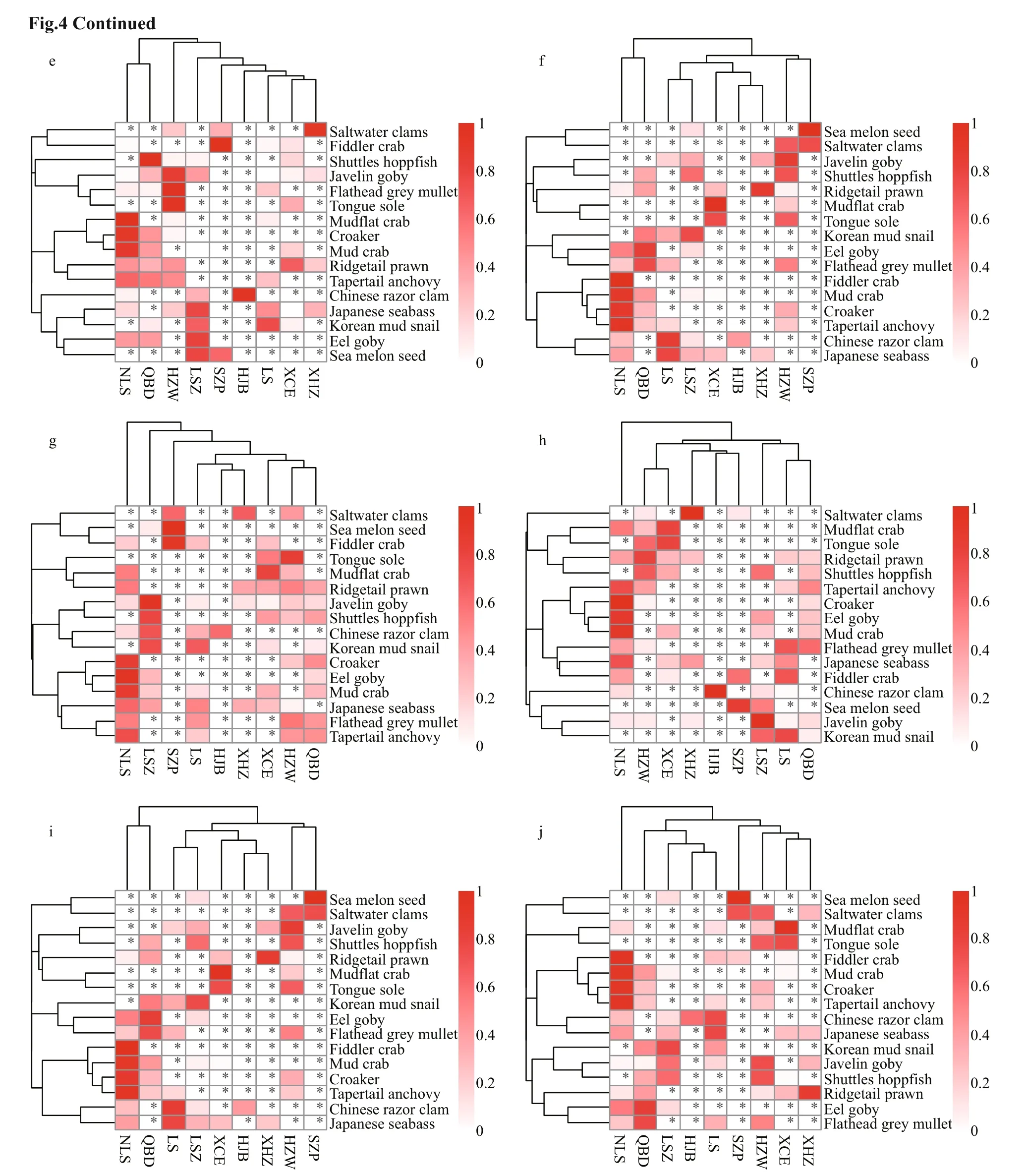
Fig.4 Heatmaps for noncarcinogenic and carcinogenic risks of chlorophenols in the different organisms and survey sections
4.2 Analysis of chlorophenol concentrations and the chlorophenol congener profi les
The total chlorophenol concentrations were highest in the SZP and HJB sections, and the total chlorophenol concentrations were higher in the NLS and LST sections than in the remaining sections (Fig.2). We assumed that the concentrations differed because of location Specific factors. The SZP section is near a leachate outlet for the Xishan landfi ll and the HJB section is near a sewage outlet in Huangjiabu. As the Huangjiabu sewage outlet is actually near to the HJB,LS, XCE and HZB sections, discharged contaminants could inf l uence all four sections. Qiu et al. (2016)found that this sewage outlet contains discharge from electroplating processes and that the eラ uent contains heavy metals, metal complexing agents, organic solvents and other organic compounds, which could be chlorophenol sources. Similarly, the NLS and LST sections are near the Zhenhai Refi ning and Chemical Industry sewage outlet; as a result, the chlorophenol concentrations in the samples from these two sections were also high. We therefore speculate that biological and non-biological waste discharge are the main sources of chlorophenols in Hangzhou Bay. As chlorophenols are not produced in the natural environment (Stringer and Johnston, 2001; Karci,2014), chlorophenols or chlorophenol precursors must have been released into Hangzhou Bay in discharge from chemical plants established during the rapid industrialization of the area. Chlorophenols are commonly used in industrial processes, are very toxic and widely distributed in the environment. The US EPA classifi es chlorophenols as priority pollutants because they are persistent and negatively affect ecological systems. Consideration thus needs to be given to mitigating environmental harm caused by chlorophenols by effectively controlling pollutant discharge, establishing water purifi cation treatment procedures, and encouraging the chlorophenol biodegradation.
4.3 Assessment of health risks to humans from consumption of chlorophenols
Attention is increasingly focused on food safety concerns (Jin et al., 2012b), but these are complex issues because there are many aspects of food safety(Johnson and Finley, 1980). There are currently numerous international and national standards for many pollutants in food, but there are still no standards for chlorophenols. The risks posed to humans by all 19 chlorophenols in marine organisms from Hangzhou Bay were assessed using statistical methods derived from an integrated risk information system.Additionally, the noncarcinogenic and carcinogenic risks posed by several individual chlorophenols were assessed. The noncarcinogenic risks were evaluated using threshold indices where the risks posed by a particular substance were considered controllable when the risk threshold index for that substance was<0.1 and the environmental risk was considered low.The carcinogenic risks were evaluated using a nonthreshold evaluation method derived in a previous study (Whelan et al., 1987). In regulations set by the International Commission on Radiological Protection,the maximum annual carcinogenic risk index is 5×10-5,and the maximum annual carcinogenic risk index set by the US EPA is 1×10-4to 5×10-6. The noncarcinogenic risk indices for all of the organisms we analyzed were<0.1 (ranging 10-5to 10-2); thus, we concluded that the noncarcinogenic risks posed by 2-CP, 2,4-DCP, 2,4,6-TCP, 2,4,5-TCP, 2,3,4,6-TTCP, and PCP were not high. The statistical results also showed that the carcinogenic risks posed by 2,4,6-TCP and PCP were less than the standards set by the International Commission on Radiological Protection and the US EPA, so we concluded that the carcinogenic risks posed by 2,4,6-TCP and PCP were also not high.
The noncarcinogenic and carcinogenic risk threshold indices were low for the organisms from all of the survey sections, but the risks varied for different survey sections and for different organisms. The noncarcinogenic risks posed by 2-CP, 2,4-DCP, 2,4,6-TCP, 2,4,5-TCP, 2,3,4,6-TTCP, PCP and total chlorophenols, and the carcinogenic risks posed by 2,4,6-TCP, PCP and total chlorophenols are shown in Fig.4a-j. The risk indices for the survey sections and organisms were very different. The noncarcinogenic risk indices for 2-CP (Fig.4a) were high for Japanese seabass, Korean mud snail, mud crab, javelin goby,shuttles hoppfish and Chinese razor clam in the XCE,LST and NLS sections. The noncarcinogenic risk indices for 2-CP in fi ddler crab, sea melon seed, and saltwater clam were higher in the SZP section than in the other survey sections. The risk indices for the different organisms in the NLS section were higher than in the other sections, and the risk indices for croaker and tongue sole in the QBI and HZB sections were also high. The comprehensive carcinogenic risks posed by 2,4,6-TCP (Fig.4h) and PCP (Fig.4i) were determined from hierarchical clusters in Q-type cluster analysis based on the Euclidean distances. The risk indices again differed for different organisms and survey sections, and the highest and lowest risk indices in each section were for different organisms. For example, the risk indices for tapertail anchovy, croaker,mud crab, and fi ddler crab were high in the NLS section, high for Japanese seabass and Chinese razor clam in the LS section, high for flathead grey mullet and eel goby in the QBI section, and high for Korean mud snail, tongue sole, mudf l at crab, ridgetail prawn,and sea melon seed in the LST, XCE, XHZ, HZB, and SZP sections, respectively (Fig.4h-j).
Overall, for each chlorophenol, the differences between concentrations in different organisms were not significantly different (P>0.05), but the noncarcinogenic and carcinogenic risks were higher for some organisms, particularly Japanese seabass,Chinese razor clam, croaker, eel goby and sea melon seed. The noncarcinogenic and carcinogenic risks were overall higher for organisms in the SZP, NLS,LST, and XHZ sections. We suggest that these differences are because an organism’s chlorophenol concentration is closely related to the chlorophenol concentration in the surrounding environment. This assertion is supported by results of a previous study(Buikema et al., 1979). Our study area is near the National Chemical Industry Park, which is one of 14 industrial clusters in Zhejiang Province. There are refi ning, printing and dyeing, synthetic material,polymer, fi ne chemical and other plants in the industrial park. Many types of pollutants are produced by these chemical industries (Nascimento et al.,2004), and some of the pollutants are inevitably discharged into the marine environment where they pose risks to the environment and public health. The concentrations of different chlorophenols were significantly different in different survey sections(P<0.01). The noncarcinogenic and carcinogenic risks were higher for organisms in the SZP, NLS,LST, and XHZ sections because these four survey sections are near the sewage outlets of different industrial parks. We therefore conclude that pollutants released from sewage outlets cause the high noncarcinogenic and carcinogenic risks posed by chlorophenols in these four sections.
The noncarcinogenic and carcinogenic risks for different organisms in all of the survey sections were below the threshold, but many types of chlorophenol were detected in the 16 analyzed species. As organisms do not produce chlorophenols (Olaniran and Igbinosa,2011), the chlorophenols must have been exogenous.We thus conclude that the marine environment is polluted with chlorophenols and recommend (1) that stricter protection measures are implemented to improve environmental quality in the study area and(2) standards for levels of chlorophenols in organisms are established as soon as possible.
5 CONCLUSION
The results showed that the CP concentrations were higher than the concentrations of the DCPs,TCPs, TTCPs, and PCP in all of the survey sections.We conclude that the primary chlorophenol pollutants in Hangzhou Bay are CPs. All 19 chlorophenol compounds were widely distributed in the marine organisms collected in Hangzhou Bay, and the detection rates and concentrations were higher than in other studies. The noncarcinogenic risks posed by 2-CP, 2,4-DCP, 2,4,6-TCP, 2,4,5-TCP, 2,3,4,6-TTCP and PCP were not high, and the carcinogenic risks posed by 2,4,6-TCP and PCP were below the limits set by the International Commission on Radiological Protection and the US EPA. However, the noncarcinogenic and carcinogenic risks were higher for organisms in the SZP, NLS, LST, and XHZ sections. These results indicate that the chlorophenols were released from sewage outlets because chlorophenols are exogenous and are not produced by organisms. The high detection rates for chlorophenols indicate that more attention should be paid to food safety of humans ingesting marine organisms from Hangzhou Bay than is currently the case.
6 DATA AVAILABILITY STATEMENT
Data sharing is not applicable as no datasets were generated or analyzed during the current study.
7 ACKNOWLEDGEMENT
The authors wish to thank the many colleagues that assisted with the collection and analysis of marine organism samples.
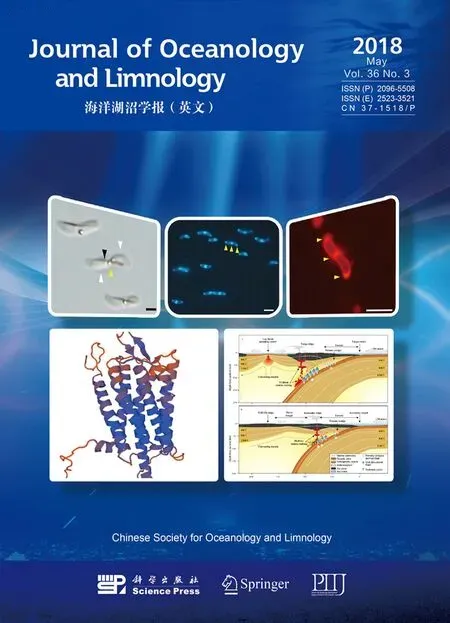 Journal of Oceanology and Limnology2018年3期
Journal of Oceanology and Limnology2018年3期
- Journal of Oceanology and Limnology的其它文章
- Editorial Statement
- The post-larval and juvenile fi sh assemblage in the Sukhothai Floodplain, Thailand*
- Effects of probiotic on microf l oral structure of live feed used in larval breeding of turbotScophthalmus maximus*
- Comparison ofintestinal microbiota and activities of digestive and immune-related enzymes of sea cucumberApostichopus japonicusin two habitats*
- Otolith shape analysis for stock discrimination of twoCollichthysgenus croaker (Pieces: Sciaenidae,) from the northern Chinese coast*
- The impact of spatial autocorrelation on CPUE standardization between two different fi sheries*
